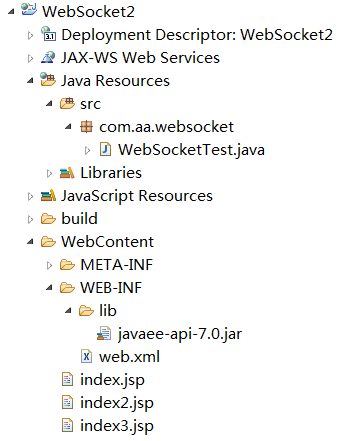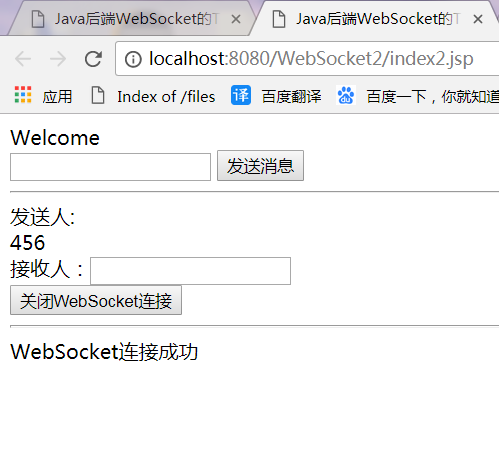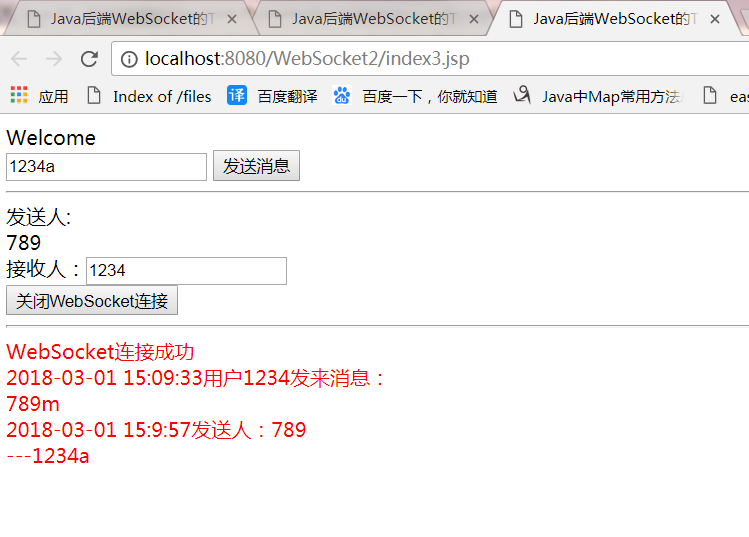一.WebSocket简单介绍
随着互联网的发展,传统的HTTP协议已经很难满足Web应用日益复杂的需求了。近年来,随着HTML5的诞生,WebSocket协议被提出,它实现了浏览器与服务器的全双工通信,扩展了浏览器与服务端的通信功能,使服务端也能主动向客户端发送数据。
我们知道,传统的HTTP协议是无状态的,每次请求(request)都要由客户端(如 浏览器)主动发起,服务端进行处理后返回response结果,而服务端很难主动向客户端发送数据;这种客户端是主动方,服务端是被动方的传统Web模式 对于信息变化不频繁的Web应用来说造成的麻烦较小,而对于涉及实时信息的Web应用却带来了很大的不便,如带有即时通信、实时数据、订阅推送等功能的应 用。在WebSocket规范提出之前,开发人员若要实现这些实时性较强的功能,经常会使用折衷的解决方法:轮询(polling)和Comet技术。其实后者本质上也是一种轮询,只不过有所改进。
轮询是最原始的实现实时Web应用的解决方案。轮询技术要求客户端以设定的时间间隔周期性地向服务端发送请求,频繁地查询是否有新的数据改动。明显地,这种方法会导致过多不必要的请求,浪费流量和服务器资源。
Comet技术又可以分为长轮询和流技术。长轮询改进了上述的轮询技术,减小了无用的请求。它会为某些数据设定过期时间,当数据过期后才会向服务端发送请求;这种机制适合数据的改动不是特别频繁的情况。流技术通常是指客户端使用一个隐藏的窗口与服务端建立一个HTTP长连接,服务端会不断更新连接状态以保持HTTP长连接存活;这样的话,服务端就可以通过这条长连接主动将数据发送给客户端;流技术在大并发环境下,可能会考验到服务端的性能。
这两种技术都是基于请求-应答模式,都不算是真正意义上的实时技术;它们的每一次请求、应答,都浪费了一定流量在相同的头部信息上,并且开发复杂度也较大。
伴随着HTML5推出的WebSocket,真正实现了Web的实时通信,使B/S模式具备了C/S模式的实时通信能力。WebSocket的工作流程是这 样的:浏览器通过JavaScript向服务端发出建立WebSocket连接的请求,在WebSocket连接建立成功后,客户端和服务端就可以通过 TCP连接传输数据。因为WebSocket连接本质上是TCP连接,不需要每次传输都带上重复的头部数据,所以它的数据传输量比轮询和Comet技术小 了很多。本文不详细地介绍WebSocket规范,主要介绍下WebSocket在Java Web中的实现。
JavaEE 7中出了JSR-356:Java API for WebSocket规范。不少Web容器,如Tomcat,Nginx,Jetty等都支持WebSocket。Tomcat从7.0.27开始支持 WebSocket,从7.0.47开始支持JSR-356,下面的Demo代码也是需要部署在Tomcat7.0.47以上的版本才能运行。
二.WebSocket示例
2.1.新建JavaWeb测试项目
在lib中加入 javaee-api-7.0.jar
客户端(Web主页)代码:
index.jsp
1 <%@ page language="java" contentType="text/html; charset=utf-8"
pageEncoding="utf-8"%>
<!DOCTYPE html PUBLIC "-//W3C//DTD HTML 4.01 Transitional//EN" "http://www.w3.org/TR/html4/loose.dtd">
<html>
<head>
<title>Java后端WebSocket的Tomcat实现</title>
</head>
<body>
Welcome<br/><input id="text" type="text"/>
<button onclick="send()">发送消息</button>
<hr/>
<!--userno:发送消息人的编号-->
发送人:<div id="userno">1234</div>
接收人:<input type="text" id="usernoto"><br>
<button onclick="closeWebSocket()">关闭WebSocket连接</button>
<hr/>
<div id="message"></div>
</body>
<script type="text/javascript">
var websocket = null;
var userno=document.getElementById('userno').innerHTML;
//判断当前浏览器是否支持WebSocket
if ('WebSocket' in window) {
websocket = new WebSocket("ws://localhost:8080/WebSocket2/websocket/"+userno);
}
else {
alert('当前浏览器 Not support websocket')
}
//连接发生错误的回调方法
websocket.onerror = function () {
setMessageInnerHTML("WebSocket连接发生错误");
};
//连接成功建立的回调方法
websocket.onopen = function () {
setMessageInnerHTML("WebSocket连接成功");
}
//接收到消息的回调方法
websocket.onmessage = function (event) {
setMessageInnerHTML(event.data);
}
//连接关闭的回调方法
websocket.onclose = function () {
setMessageInnerHTML("WebSocket连接关闭");
}
//监听窗口关闭事件,当窗口关闭时,主动去关闭websocket连接,防止连接还没断开就关闭窗口,server端会抛异常。
window.onbeforeunload = function () {
closeWebSocket();
}
//将消息显示在网页上
function setMessageInnerHTML(sendMessage) {
document.getElementById('message').innerHTML += sendMessage + '<br/>';
}
//关闭WebSocket连接
function closeWebSocket() {
websocket.close();
}
//发送消息
function send() {
var message = document.getElementById('text').value;//要发送的消息内容
var now=getNowFormatDate();//获取当前时间
document.getElementById('message').innerHTML += (now+"发送人:"+userno+'<br/>'+"---"+message) + '<br/>';
document.getElementById('message').style.color="red";
var ToSendUserno=document.getElementById('usernoto').value; //接收人编号:4567
message=message+"|"+ToSendUserno//将要发送的信息和内容拼起来,以便于服务端知道消息要发给谁
websocket.send(message);
}
//获取当前时间
function getNowFormatDate() {
var date = new Date();
var seperator1 = "-";
var seperator2 = ":";
var month = date.getMonth() + 1;
var strDate = date.getDate();
if (month >= 1 && month <= 9) {
month = "0" + month;
}
if (strDate >= 0 && strDate <= 9) {
strDate = "0" + strDate;
}
var currentdate = date.getFullYear() + seperator1 + month + seperator1 + strDate
+ " " + date.getHours() + seperator2 + date.getMinutes()
+ seperator2 + date.getSeconds();
return currentdate;
}
</script>
</html>
index2.jsp
1<%@ page language="java" contentType="text/html; charset=utf-8"
pageEncoding="utf-8"%>
<!DOCTYPE html PUBLIC "-//W3C//DTD HTML 4.01 Transitional//EN" "http://www.w3.org/TR/html4/loose.dtd">
<html>
<head>
<title>Java后端WebSocket的Tomcat实现</title>
</head>
<body>
Welcome<br/><input id="text" type="text"/>
<button onclick="send()">发送消息</button>
<hr/>
<!--userno:发送消息人的编号-->
发送人:<div id="userno">456</div>
接收人:<input type="text" id="usernoto"><br>
<button onclick="closeWebSocket()">关闭WebSocket连接</button>
<hr/>
<div id="message"></div>
</body>
<script type="text/javascript">
var websocket = null;
var userno=document.getElementById('userno').innerHTML;
//判断当前浏览器是否支持WebSocket
if ('WebSocket' in window) {
websocket = new WebSocket("ws://localhost:8080/WebSocket2/websocket/"+userno);
}
else {
alert('当前浏览器 Not support websocket')
}
//连接发生错误的回调方法
websocket.onerror = function () {
setMessageInnerHTML("WebSocket连接发生错误");
};
//连接成功建立的回调方法
websocket.onopen = function () {
setMessageInnerHTML("WebSocket连接成功");
}
//接收到消息的回调方法
websocket.onmessage = function (event) {
setMessageInnerHTML(event.data);
}
//连接关闭的回调方法
websocket.onclose = function () {
setMessageInnerHTML("WebSocket连接关闭");
}
//监听窗口关闭事件,当窗口关闭时,主动去关闭websocket连接,防止连接还没断开就关闭窗口,server端会抛异常。
window.onbeforeunload = function () {
closeWebSocket();
}
//将消息显示在网页上
function setMessageInnerHTML(sendMessage) {
document.getElementById('message').innerHTML += sendMessage + '<br/>';
}
//关闭WebSocket连接
function closeWebSocket() {
websocket.close();
}
//发送消息
function send() {
var message = document.getElementById('text').value;//要发送的消息内容
var now=getNowFormatDate();//获取当前时间
document.getElementById('message').innerHTML += (now+"发送人:"+userno+'<br/>'+"---"+message) + '<br/>';
document.getElementById('message').style.color="red";
var ToSendUserno=document.getElementById('usernoto').value; //接收人编号:4567
message=message+"|"+ToSendUserno//将要发送的信息和内容拼起来,以便于服务端知道消息要发给谁
websocket.send(message);
}
//获取当前时间
function getNowFormatDate() {
var date = new Date();
var seperator1 = "-";
var seperator2 = ":";
var month = date.getMonth() + 1;
var strDate = date.getDate();
if (month >= 1 && month <= 9) {
month = "0" + month;
}
if (strDate >= 0 && strDate <= 9) {
strDate = "0" + strDate;
}
var currentdate = date.getFullYear() + seperator1 + month + seperator1 + strDate
+ " " + date.getHours() + seperator2 + date.getMinutes()
+ seperator2 + date.getSeconds();
return currentdate;
}
</script>
</html>
index3.jsp
1 <%@ page language="java" contentType="text/html; charset=utf-8"
pageEncoding="utf-8"%>
<!DOCTYPE html PUBLIC "-//W3C//DTD HTML 4.01 Transitional//EN" "http://www.w3.org/TR/html4/loose.dtd">
<html>
<head>
<title>Java后端WebSocket的Tomcat实现</title>
</head>
<body>
Welcome<br/><input id="text" type="text"/>
<button onclick="send()">发送消息</button>
<hr/>
<!--userno:发送消息人的编号-->
发送人:<div id="userno">789</div>
接收人:<input type="text" id="usernoto"><br>
<button onclick="closeWebSocket()">关闭WebSocket连接</button>
<hr/>
<div id="message"></div>
</body>
<script type="text/javascript">
var websocket = null;
var userno=document.getElementById('userno').innerHTML;
//判断当前浏览器是否支持WebSocket
if ('WebSocket' in window) {
websocket = new WebSocket("ws://localhost:8080/WebSocket2/websocket/"+userno);
}
else {
alert('当前浏览器 Not support websocket')
}
//连接发生错误的回调方法
websocket.onerror = function () {
setMessageInnerHTML("WebSocket连接发生错误");
};
//连接成功建立的回调方法
websocket.onopen = function () {
setMessageInnerHTML("WebSocket连接成功");
}
//接收到消息的回调方法
websocket.onmessage = function (event) {
setMessageInnerHTML(event.data);
}
//连接关闭的回调方法
websocket.onclose = function () {
setMessageInnerHTML("WebSocket连接关闭");
}
//监听窗口关闭事件,当窗口关闭时,主动去关闭websocket连接,防止连接还没断开就关闭窗口,server端会抛异常。
window.onbeforeunload = function () {
closeWebSocket();
}
//将消息显示在网页上
function setMessageInnerHTML(sendMessage) {
document.getElementById('message').innerHTML += sendMessage + '<br/>';
}
//关闭WebSocket连接
function closeWebSocket() {
websocket.close();
}
//发送消息
function send() {
var message = document.getElementById('text').value;//要发送的消息内容
var now=getNowFormatDate();//获取当前时间
document.getElementById('message').innerHTML += (now+"发送人:"+userno+'<br/>'+"---"+message) + '<br/>';
document.getElementById('message').style.color="red";
var ToSendUserno=document.getElementById('usernoto').value; //接收人编号:4567
message=message+"|"+ToSendUserno//将要发送的信息和内容拼起来,以便于服务端知道消息要发给谁
websocket.send(message);
}
//获取当前时间
function getNowFormatDate() {
var date = new Date();
var seperator1 = "-";
var seperator2 = ":";
var month = date.getMonth() + 1;
var strDate = date.getDate();
if (month >= 1 && month <= 9) {
month = "0" + month;
}
if (strDate >= 0 && strDate <= 9) {
strDate = "0" + strDate;
}
var currentdate = date.getFullYear() + seperator1 + month + seperator1 + strDate
+ " " + date.getHours() + seperator2 + date.getMinutes()
+ seperator2 + date.getSeconds();
return currentdate;
}
</script>
</html>
Java Web后端代码
1 package com.aa.websocket;
import javax.websocket.*;
import javax.websocket.server.PathParam;
import javax.websocket.server.ServerEndpoint;
import java.io.IOException;
import java.text.DateFormat;
import java.text.SimpleDateFormat;
import java.util.Date;
import java.util.concurrent.ConcurrentHashMap;
/**
* @ServerEndpoint 注解是一个类层次的注解,它的功能主要是将目前的类定义成一个websocket服务器端,
* 注解的值将被用于监听用户连接的终端访问URL地址,客户端可以通过这个URL来连接到WebSocket服务器端
* @ServerEndpoint 可以把当前类变成websocket服务类
*/
@ServerEndpoint("/websocket/{userno}")
public class WebSocketTest {
//静态变量,用来记录当前在线连接数。应该把它设计成线程安全的。
private static int onlineCount = 0;
//concurrent包的线程安全Set,用来存放每个客户端对应的MyWebSocket对象。若要实现服务端与单一客户端通信的话,可以使用Map来存放,其中Key可以为用户标识
private static ConcurrentHashMap<String, WebSocketTest> webSocketSet = new ConcurrentHashMap<String, WebSocketTest>();
//与某个客户端的连接会话,需要通过它来给客户端发送数据
private Session WebSocketsession;
//当前发消息的人员编号
private String userno = "";
/**
* 连接建立成功调用的方法
*
* @param session 可选的参数。session为与某个客户端的连接会话,需要通过它来给客户端发送数据
*/
@OnOpen
public void onOpen(@PathParam(value = "userno") String param, Session WebSocketsession, EndpointConfig config) {
System.out.println(param);
userno = param;//接收到发送消息的人员编号
this.WebSocketsession = WebSocketsession;
webSocketSet.put(param, this);//加入map中
addOnlineCount(); //在线数加1
System.out.println("有新连接加入!当前在线人数为" + getOnlineCount());
}
/**
* 连接关闭调用的方法
*/
@OnClose
public void onClose() {
if (!userno.equals("")) {
webSocketSet.remove(userno); //从set中删除
subOnlineCount(); //在线数减1
System.out.println("有一连接关闭!当前在线人数为" + getOnlineCount());
}
}
/**
* 收到客户端消息后调用的方法
*
* @param message 客户端发送过来的消息
* @param session 可选的参数
*/
@SuppressWarnings("unused")
// @OnMessage
public void onMessage(String message, Session session) {
System.out.println("来自客户端的消息:" + message);
// session.get
//群发消息
if (1 < 2) {
sendAll(message);
} else {
//给指定的人发消息
sendToUser(message);
}
}
/**
* 给指定的人发送消息
* @param message
*/
@OnMessage
public void sendToUser(String message) {
String sendUserno = message.split("[|]")[1];
String sendMessage = message.split("[|]")[0];
String now = getNowTime();
try {
if (webSocketSet.get(sendUserno) != null) {
webSocketSet.get(sendUserno).sendMessage(now + "用户" + userno + "发来消息:" + " <br/> " + sendMessage);
} else {
System.out.println("当前用户不在线");
}
} catch (IOException e) {
e.printStackTrace();
}
}
/**
* 给所有人发消息
* @param message
*/
private void sendAll(String message) {
String now = getNowTime();
String sendMessage = message.split("[|]")[0];
//遍历HashMap
for (String key : webSocketSet.keySet()) {
try {
//判断接收用户是否是当前发消息的用户
if (!userno.equals(key)) {
webSocketSet.get(key).sendMessage(now + "用户" + userno + "发来消息:" + " <br/> " + sendMessage);
System.out.println("key = " + key);
}
} catch (IOException e) {
e.printStackTrace();
}
}
}
/**
* 获取当前时间
*
* @return
*/
private String getNowTime() {
Date date = new Date();
DateFormat format = new SimpleDateFormat("yyyy-MM-dd HH:mm:ss");
String time = format.format(date);
return time;
}
/**
* 发生错误时调用
*
* @param session
* @param error
*/
@OnError
public void onError(Session session, Throwable error) {
System.out.println("发生错误");
error.printStackTrace();
}
/**
* 这个方法与上面几个方法不一样。没有用注解,是根据自己需要添加的方法。
*
* @param message
* @throws IOException
*/
public void sendMessage(String message) throws IOException {
this.WebSocketsession.getBasicRemote().sendText(message);
//this.session.getAsyncRemote().sendText(message);
}
public static synchronized int getOnlineCount() {
return onlineCount;
}
public static synchronized void addOnlineCount() {
WebSocketTest.onlineCount++;
}
public static synchronized void subOnlineCount() {
WebSocketTest.onlineCount--;
}
}
1.2.运行效果
页面1与页面3互相发送消息,页面2收不到任何信息
转载:https://blog.csdn.net/qq_39478853/article/details/79413453
T



